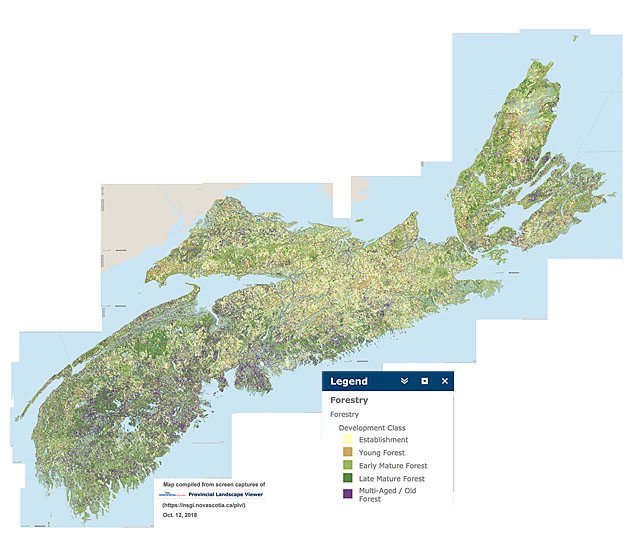DRAFTING Jan19, 2019 …
As some guide to where Old Growth is likely to occur (if anywhere at all), in Nova Scotia, one can look at the Development Class Layer in the Nova Scotia Provincial Landscape Viewer.
From the Help Page:
This layer describes the structure of forests as they age and grow (e.g. forest establishment, young forest, mature forest).Four development classes describe the structure of forests as they age and grow. Assignments are based on stand height:
· Establishment (Height 0-6m): Influx of new growth following a stand initiating disturbance, and characterized by a high diversity of forbs, shrubs, and tree regeneration.
· Young Stem Exclusion (Height 7-11 m): Young developing tree canopies characterized by vigorous self thinning, crown differentiation, and competitive exclusion of many individuals.
· Mature (Height > 11 m): Stands dominated by upper canopy trees with full differentiation into dominance classes. Canopy gaps are soon closed by neighbouring tree growth.
· Multi-age and Old Growth (Age 999 and Old Forest Policy): Overstory exhibiting a variety of crown sizes and canopy densities. Canopy gaps are persistent promoting multi-layered understory development and recruitment to the overstory.
Here is a map for the whole province which I compiled from screen captures of views in the PLV – but go to the PLV to confirm (or not) where a particular stand lies in relation to the mapped Development Stage.

Distribution of forest in 5 development stages across Nova Scotia, compiled from NS Landscape Map Viewer. Purple = Multi-aged/Old Forest. View larger versions of the map: 2000 px | 4000 px.
(You may have to Save the larger image and open it on your device to view at full size).
…More to be written on this page (admin, Jan 3, 2019); ‘may take a while
Also see: Compiled Maps
